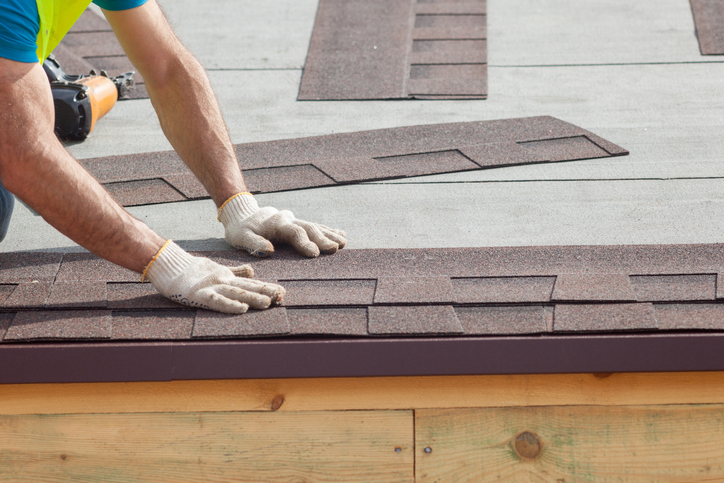How to Tell When You Need a Roof Replacement
Published on Wednesday March 29, 2017Do you need a roof replacement? Would you know if you did? Sometimes, the signs can be pretty obvious — i.e., the ability to spot the Big Dipper from your attic — but in most circumstances, the red flags of a failing roof are more subtle.
Let’s take a look at what your roof may be trying to tell you.
Understanding the whole roof system
Before calling a roofing pro, make sure you know the lingo. Here are the components of the whole roof system:
- Deck: The wooden, structural surface of the roof.
- Drip edge: Material affixed along the edge of the roof to guide water off the eaves.
- Underlayment: A barrier installed under the shingles to keep the deck dry.
- Flashing: Material affixed to seal and protect joints, such as where the roof meets the chimney.
- Shingles: The outermost layer of your roof, which repels water and protects the structure.
- Soffit: The underside of a roof overhang.
- Fascia: The horizontal board on the end of your roof’s rafters that may hold the gutters.
- Vents: Features that allow air to escape the attic and keep your roof dry.
A roof can be made of different materials. The SureStart PLUS roof, for example, requires the use of both Winterguard and either Roofer’s Select or Diamond Deck underlayment. Starter shingles, specific CertainTeed asphalt shingles, ridge vents and both hip and ridge caps are also components of a SureStart PLUS roof. With these product requirements, customers also get a 50-year warranty.
6 signs you need a roof replacement
Now that you understand what goes into your roof, keep an eye out for these signs:
1. You have an old roof.

The average asphalt shingle roof lasts about 12 to 15 years. Metal or tile roofs tend to have a longer lifespan. If your roof is nearing its typical replacement age, you should probably start thinking about your next roof.
If previous roof repairs were installed over the top of your existing roof — a practice known as overlaying — you should definitely think about a roof replacement. Overlaying is a quick fix that can hide bigger roofing issues beneath the shingle surface.
2. Curling or missing shingles are visible.

Your roof is exposed to elements like rain, snow, and sun, causing the components to wear down over time.
This long-term beating from Mother Nature can result in broken, missing, buckling or curling shingles. Finding debris — or granules — from your shingles in your gutter system is a telltale sign of roof decay. Any missing parts of your roof makes your home vulnerable to the elements.
3. You can see broken or damaged flashing.
Flashing helps keep moisture out at the joints in your roofing system. Depending on the quality and the age of your roof, the flashing may be made of roof cement, tar, or metal. Damaged, degraded, or missing flashing means your roof is at risk for water damage.
4. Ice damming.

The appearance of ice dams (ridges of ice that form at your roof’s edge) likely means you have roof ventilation issues.
When your roof is not properly ventilated, heat from the attic can melt the snow on your roof. This snow melt runs off the edge of your roof or into your gutters, where the cold air promptly causes it to freeze. This ice dam causes the next wave of snow melt to backup and freeze, too.
The process creates the dramatic icicles you sometimes see hanging from a home. The added ice pressure can pull apart your roofing materials, allowing the water backup to seep into the inner layers of your roof.
Once water starts to soak those inner materials, it’s only a matter of time before you need a roof replacement.
5. Discolored ceilings and walls.
Have you noticed mysterious water stains on your ceilings, walls, or the exterior of your home? Do you hear a mysterious dripping sound coming from your ceiling? You may have a leak in your roof.
Check the insulation in your attic — if it’s soggy, that probably means you have a problem.
Walking on your roof is dangerous and not recommended! If you have ascended to the top of your home (again, not recommended) and found soft sections in your roofing, your roof likely has water damage and needs to be replaced.
6. You have unwanted animal occupants in your home.

Has a family of squirrels taken up residence in your attic? It’s doubtful you let them in the front door, so it’s likely you have a missing or rotting section in the eaves or a hole in another part of your roof.
Animals like possums, raccoons, birds, and bats will look for any opportunity to nest in the comfort of your warm home and will take advantage of damage to your roof.
Hire a professional roofing contractor to inspect your roof to determine whether repairs or a total replacement are required.
Tips to keep your roof in top shape
Once you decide you need a new roof, follow these steps to ensure your roof replacement stays in tip-top shape for as long as possible:
- Get a warranty. When you purchase a warranty, you’re not just ensuring that future repairs are covered — you’re committing to a higher-quality roof.
- Hire a tree cutter. Trim trees near your home so they don’t become projectiles during a storm or superhighways for animals to access your roof.
- Inspect your roof for damage after a storm. Don’t assume everything is OK after your neighborhood is blasted by snow, hail or wind.
- Abide by the terms of your roofing warranty. You paid for it! Make sure you follow the terms of the warranty to ensure that when you need it, you can use it.
Need a new roof?
It may be time to replace your roof. Contact us online to request an estimate for a roof replacement. We build trust and peace of mind into every Long Roof.
Interested in Long Home Products?
See our special offers now.
*Excludes labor. Subject to credit approval.
**Excludes labor. Subject to credit approval.
One-day installs contingent upon municipal rules and regulations.
By submitting a form, I authorize Long Home Products to contact me with information abouts its products and services via mail, email, phone and/or text at the contact information provided, even if I am on the national do not call list. Long Home Products may use automated telephone technology to initiate calls to its customers. Calls and in person estimates may be recorded for quality and training purposes.









